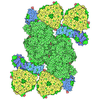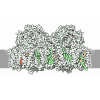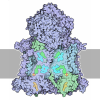+ Open data
Open data
- Basic information
Basic information
| Entry | Database: PDB / ID: 9m4f | |||||||||||||||
|---|---|---|---|---|---|---|---|---|---|---|---|---|---|---|---|---|
| Title | Photosystem I from the eukaryotic filamentous algae | |||||||||||||||
 Components Components |
| |||||||||||||||
 Keywords Keywords | PHOTOSYNTHESIS / Photosystem I / Xanthophyceae / Tribonema minus | |||||||||||||||
| Function / homology | : / BETA-CAROTENE / CHLOROPHYLL A / Chem-DD6 / 1,2-DIPALMITOYL-PHOSPHATIDYL-GLYCEROLE / 1,2-DISTEAROYL-MONOGALACTOSYL-DIGLYCERIDE / PHYLLOQUINONE / IRON/SULFUR CLUSTER Function and homology information Function and homology information | |||||||||||||||
| Biological species |  Tribonema minus (eukaryote) Tribonema minus (eukaryote) | |||||||||||||||
| Method | ELECTRON MICROSCOPY / single particle reconstruction / cryo EM / Resolution: 2.82 Å | |||||||||||||||
 Authors Authors | Shao, R.Q. / Pan, X.W. | |||||||||||||||
| Funding support |  China, 4items China, 4items
| |||||||||||||||
 Citation Citation |  Journal: J Integr Plant Biol / Year: 2025 Journal: J Integr Plant Biol / Year: 2025Title: Architecture of photosystem I-light-harvesting complex from the eukaryotic filamentous yellow-green alga Tribonema minus. Authors: Ruiqi Shao / Yuqi Zou / Hui Shang / Yue Qiu / Zuxing Liang / Xiaodong Su / Shumeng Zhang / Mei Li / Xiaowei Pan /  Abstract: Eukaryotic photosystem I (PSI) is a multi-subunit pigment-protein supercomplex that consists of a core complex and multiple peripheral light-harvesting complexes I (LHCIs), which increases the light ...Eukaryotic photosystem I (PSI) is a multi-subunit pigment-protein supercomplex that consists of a core complex and multiple peripheral light-harvesting complexes I (LHCIs), which increases the light absorption capacity of the core complex. Throughout the evolution of oxygenic photoautotrophs, the core subunits of PSI have remained highly conserved, while LHCIs exhibit significant variability, presumably to adapt to diverse environments. This study presents a 2.82 Å resolution structure of PSI from the filamentous yellow-green alga Tribonema minus (Tm), a member of the class Xanthophyceae that evolved from red algae through endosymbiosis and is considered a promising candidate for biofuel production due to its high biomass and lipid content. Our structure reveals a supramolecular organization consisting of 12 core subunits and 13 LHCIs, here referred to as Xanthophyceae light-harvesting complexes (XLHs), along with the arrangement of pigments within the TmPSI-XLH supercomplex. A structural comparison between TmPSI-XLH and PSI-LHCI from various red lineages highlights distinctive features of TmPSI-XLH, suggesting that it represents a unique intermediate state in the PSI assembly process during the evolutionary transition from red algae to diatoms. Our findings advance the understanding of the molecular mechanisms responsible for energy transfer in Xanthophyceae PSI-XLH and the evolutionary adaptation of red lineages. | |||||||||||||||
| History |
|
- Structure visualization
Structure visualization
| Structure viewer | Molecule:  Molmil Molmil Jmol/JSmol Jmol/JSmol |
|---|
- Downloads & links
Downloads & links
- Download
Download
| PDBx/mmCIF format |  9m4f.cif.gz 9m4f.cif.gz | 1.3 MB | Display |  PDBx/mmCIF format PDBx/mmCIF format |
|---|---|---|---|---|
| PDB format |  pdb9m4f.ent.gz pdb9m4f.ent.gz | Display |  PDB format PDB format | |
| PDBx/mmJSON format |  9m4f.json.gz 9m4f.json.gz | Tree view |  PDBx/mmJSON format PDBx/mmJSON format | |
| Others |  Other downloads Other downloads |
-Validation report
| Summary document |  9m4f_validation.pdf.gz 9m4f_validation.pdf.gz | 17.1 MB | Display |  wwPDB validaton report wwPDB validaton report |
|---|---|---|---|---|
| Full document |  9m4f_full_validation.pdf.gz 9m4f_full_validation.pdf.gz | 17.8 MB | Display | |
| Data in XML |  9m4f_validation.xml.gz 9m4f_validation.xml.gz | 204.3 KB | Display | |
| Data in CIF |  9m4f_validation.cif.gz 9m4f_validation.cif.gz | 244.1 KB | Display | |
| Arichive directory |  https://data.pdbj.org/pub/pdb/validation_reports/m4/9m4f https://data.pdbj.org/pub/pdb/validation_reports/m4/9m4f ftp://data.pdbj.org/pub/pdb/validation_reports/m4/9m4f ftp://data.pdbj.org/pub/pdb/validation_reports/m4/9m4f | HTTPS FTP |
-Related structure data
| Related structure data |  63625MC M: map data used to model this data C: citing same article ( |
|---|---|
| Similar structure data | Similarity search - Function & homology  F&H Search F&H Search |
- Links
Links
- Assembly
Assembly
| Deposited unit | 
|
|---|---|
| 1 |
|
- Components
Components
-Light-harvesting protein ... , 11 types, 13 molecules 123456h789kct
| #1: Protein | Mass: 23276.188 Da / Num. of mol.: 1 / Source method: isolated from a natural source / Source: (natural)  Tribonema minus (eukaryote) Tribonema minus (eukaryote) | ||||||||||
|---|---|---|---|---|---|---|---|---|---|---|---|
| #2: Protein | Mass: 20953.053 Da / Num. of mol.: 1 / Source method: isolated from a natural source / Source: (natural)  Tribonema minus (eukaryote) Tribonema minus (eukaryote) | ||||||||||
| #3: Protein | Mass: 21701.898 Da / Num. of mol.: 1 / Source method: isolated from a natural source / Source: (natural)  Tribonema minus (eukaryote) Tribonema minus (eukaryote) | ||||||||||
| #4: Protein | Mass: 24273.383 Da / Num. of mol.: 1 / Source method: isolated from a natural source / Source: (natural)  Tribonema minus (eukaryote) Tribonema minus (eukaryote) | ||||||||||
| #5: Protein | Mass: 22618.105 Da / Num. of mol.: 1 / Source method: isolated from a natural source / Source: (natural)  Tribonema minus (eukaryote) Tribonema minus (eukaryote) | ||||||||||
| #6: Protein | Mass: 22235.654 Da / Num. of mol.: 2 / Source method: isolated from a natural source / Source: (natural)  Tribonema minus (eukaryote) Tribonema minus (eukaryote)#7: Protein | | Mass: 22124.809 Da / Num. of mol.: 1 / Source method: isolated from a natural source / Source: (natural)  Tribonema minus (eukaryote) Tribonema minus (eukaryote)#8: Protein | | Mass: 19510.305 Da / Num. of mol.: 1 / Source method: isolated from a natural source / Source: (natural)  Tribonema minus (eukaryote) Tribonema minus (eukaryote)#9: Protein | Mass: 23143.885 Da / Num. of mol.: 2 / Source method: isolated from a natural source / Source: (natural)  Tribonema minus (eukaryote) Tribonema minus (eukaryote)#10: Protein | | Mass: 21832.453 Da / Num. of mol.: 1 / Source method: isolated from a natural source / Source: (natural)  Tribonema minus (eukaryote) Tribonema minus (eukaryote)#11: Protein | | Mass: 24538.900 Da / Num. of mol.: 1 / Source method: isolated from a natural source / Source: (natural)  Tribonema minus (eukaryote) Tribonema minus (eukaryote) |
-Protein , 9 types, 9 molecules ABCDEFLRS
| #12: Protein | Mass: 83163.406 Da / Num. of mol.: 1 / Source method: isolated from a natural source / Source: (natural)  Tribonema minus (eukaryote) Tribonema minus (eukaryote) |
|---|---|
| #13: Protein | Mass: 82145.773 Da / Num. of mol.: 1 / Source method: isolated from a natural source / Source: (natural)  Tribonema minus (eukaryote) Tribonema minus (eukaryote) |
| #14: Protein | Mass: 8737.103 Da / Num. of mol.: 1 / Source method: isolated from a natural source / Source: (natural)  Tribonema minus (eukaryote) Tribonema minus (eukaryote) |
| #15: Protein | Mass: 15405.666 Da / Num. of mol.: 1 / Source method: isolated from a natural source / Source: (natural)  Tribonema minus (eukaryote) Tribonema minus (eukaryote) |
| #16: Protein | Mass: 7013.938 Da / Num. of mol.: 1 / Source method: isolated from a natural source / Source: (natural)  Tribonema minus (eukaryote) Tribonema minus (eukaryote) |
| #17: Protein | Mass: 20668.137 Da / Num. of mol.: 1 / Source method: isolated from a natural source / Source: (natural)  Tribonema minus (eukaryote) Tribonema minus (eukaryote) |
| #20: Protein | Mass: 15801.178 Da / Num. of mol.: 1 / Source method: isolated from a natural source / Source: (natural)  Tribonema minus (eukaryote) Tribonema minus (eukaryote) |
| #22: Protein | Mass: 9267.573 Da / Num. of mol.: 1 / Source method: isolated from a natural source / Source: (natural)  Tribonema minus (eukaryote) Tribonema minus (eukaryote) |
| #23: Protein | Mass: 11422.071 Da / Num. of mol.: 1 / Source method: isolated from a natural source / Source: (natural)  Tribonema minus (eukaryote) Tribonema minus (eukaryote) |
-Protein/peptide , 3 types, 3 molecules IJM
| #18: Protein/peptide | Mass: 3940.727 Da / Num. of mol.: 1 / Source method: isolated from a natural source / Source: (natural)  Tribonema minus (eukaryote) Tribonema minus (eukaryote) |
|---|---|
| #19: Protein/peptide | Mass: 4792.570 Da / Num. of mol.: 1 / Source method: isolated from a natural source / Source: (natural)  Tribonema minus (eukaryote) Tribonema minus (eukaryote) |
| #21: Protein/peptide | Mass: 3249.002 Da / Num. of mol.: 1 / Source method: isolated from a natural source / Source: (natural)  Tribonema minus (eukaryote) Tribonema minus (eukaryote) |
-Sugars , 1 types, 7 molecules 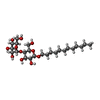
| #27: Sugar | ChemComp-LMT / |
|---|
-Non-polymers , 8 types, 331 molecules 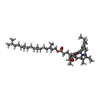
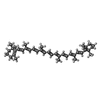

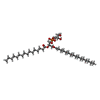
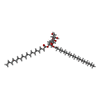
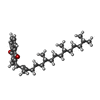
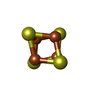






| #24: Chemical | ChemComp-CLA / #25: Chemical | ChemComp-BCR / #26: Chemical | ChemComp-DD6 / ( #28: Chemical | ChemComp-LHG / #29: Chemical | ChemComp-A1L1G / ( Mass: 616.870 Da / Num. of mol.: 5 / Source method: obtained synthetically / Formula: C40H56O5 / Feature type: SUBJECT OF INVESTIGATION #30: Chemical | #31: Chemical | #32: Chemical | |
|---|
-Details
| Has ligand of interest | Y |
|---|---|
| Has protein modification | Y |
-Experimental details
-Experiment
| Experiment | Method: ELECTRON MICROSCOPY |
|---|---|
| EM experiment | Aggregation state: PARTICLE / 3D reconstruction method: single particle reconstruction |
- Sample preparation
Sample preparation
| Component | Name: Photosystem I-Light-Harvesting Complexes from the Eukaryotic Filamentous Yellow-Green Algae Tribonema minus Type: COMPLEX / Entity ID: #1-#23 / Source: NATURAL |
|---|---|
| Source (natural) | Organism:  Tribonema minus (eukaryote) Tribonema minus (eukaryote) |
| Buffer solution | pH: 7.5 |
| Specimen | Embedding applied: NO / Shadowing applied: NO / Staining applied: NO / Vitrification applied: YES |
| Vitrification | Cryogen name: ETHANE |
- Electron microscopy imaging
Electron microscopy imaging
| Experimental equipment | 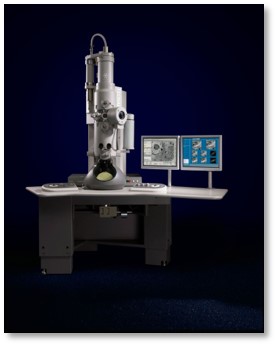 Model: Tecnai Spirit / Image courtesy: FEI Company |
|---|---|
| Microscopy | Model: FEI TECNAI SPIRIT |
| Electron gun | Electron source:  FIELD EMISSION GUN / Accelerating voltage: 300 kV / Illumination mode: SPOT SCAN FIELD EMISSION GUN / Accelerating voltage: 300 kV / Illumination mode: SPOT SCAN |
| Electron lens | Mode: BRIGHT FIELD / Nominal defocus max: 2200 nm / Nominal defocus min: 1500 nm |
| Image recording | Electron dose: 50 e/Å2 / Film or detector model: GATAN K2 SUMMIT (4k x 4k) |
- Processing
Processing
| EM software |
| ||||||||||||||||||||||||
|---|---|---|---|---|---|---|---|---|---|---|---|---|---|---|---|---|---|---|---|---|---|---|---|---|---|
| CTF correction | Type: NONE | ||||||||||||||||||||||||
| 3D reconstruction | Resolution: 2.82 Å / Resolution method: FSC 0.143 CUT-OFF / Num. of particles: 60389 / Symmetry type: POINT | ||||||||||||||||||||||||
| Refinement | Highest resolution: 2.82 Å Stereochemistry target values: REAL-SPACE (WEIGHTED MAP SUM AT ATOM CENTERS) | ||||||||||||||||||||||||
| Refine LS restraints |
|
 Movie
Movie Controller
Controller








 PDBj
PDBj
